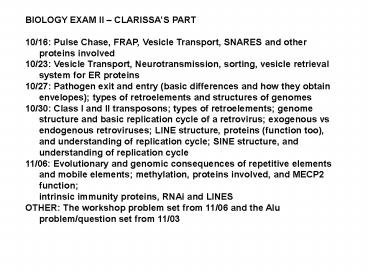BIOLOGY EXAM II CLARISSAS PART PowerPoint PPT Presentation
1 / 10
Title: BIOLOGY EXAM II CLARISSAS PART
1
BIOLOGY EXAM II CLARISSAS PART 10/16 Pulse
Chase, FRAP, Vesicle Transport, SNARES and other
proteins involved 10/23 Vesicle Transport,
Neurotransmission, sorting, vesicle retrieval
system for ER proteins 10/27 Pathogen exit and
entry (basic differences and how they obtain
envelopes) types of retroelements and structures
of genomes 10/30 Class I and II transposons
types of retroelements genome structure and
basic replication cycle of a retrovirus
exogenous vs endogenous retroviruses LINE
structure, proteins (function too), and
understanding of replication cycle SINE
structure, and understanding of replication
cycle 11/06 Evolutionary and genomic
consequences of repetitive elements and mobile
elements methylation, proteins involved, and
MECP2 function intrinsic immunity proteins,
RNAi and LINES OTHER The workshop problem set
from 11/06 and the Alu problem/question set from
11/03
2
WHAT ARE THE GENOMIC AND EVOLUTIONARY CONSEQUENCES
OF MOBILE ELEMENTS?
- Recombination hot spots
- Source of transcription promoters
- Source of regulatory elements (enhancers and
silencers) - Source of protein motifs and new gene functions
- Gene silencing
3
HOW DOES AN ORGANISM CONTROL THESE MOBILE
ELEMENTS?
- Methylation
- Intrinsic immune system
- RNAi silencing
4
Fig. 1, Part 1
METHYLATION PROTECTS AGAINST LINES, SINES, AND
ERVs
DNA Methylation Reaction Catalyzed by DNA
Methyltransferase (DNMT)
5
Methylation Inhibits LINE Expression And
Epigenetic Changes Lead to LINE Expression
6
INTRINSIC IMMUNE SYSTEM PROTECTS AGAINST ERVs
FV4
Cellular Inhibitors of Retrovirus Replication
FV1, APOBEC, TRIM5a
7
TRIM5alpha Binding to Retroviral Capsids Leads to
Accelerated Uncoating and Inhibition of RT
Emerman. PNAS April 4, 2006 vol. 103 no. 14
52495250
8
APOBEC3G A Cytidine Deaminase May Inhibit
Retroviruses
APOBEC3G edits cytosines to uracils in the minus
strand DNA copied from the viral RNA genome,
resulting in promiscuous guanine-to-adenine
(G-to-A) hypermutation of the plus (protein-coding
) strand of the viral DNA. Lentiviruses, such as
HIV and SIV, encode Vif, a protein that interacts
with APOBEC3G and targets it for
degradation. Vif of one virus will counteract
APOBEC3G from its host species
9
RNAi May Also Control The Expression of Mobile
Elements!
10
Generation of L1 dsRNA

